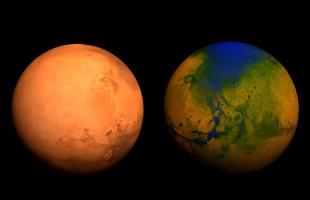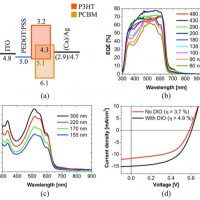Copy Link
Add to Bookmark
Report
The Martian Chronicle No 02

******************************************************************************
T h e M a r t i a n C h r o n i c l e
April 1990 No. 2
******************************************************************************
The electronic newsletter by the International Mars Patrol (I.M.P.),
an observing program of the Association of Lunar and Planetary Observers
(A.L.P.O.)
Edited by: J.D. Beish
------------------------------------------------------------------------------
INTRODUCTION
The International Mars Patrol (IMP) is a cooperative program by planetary
observers located around the Earth, that makes possible a 24-hour surveillance
of all Martian longitudes. The IMP was organized during the early 1960's by
the late Charles F. Capen and cataloged nearly 20,000 visual observations,
more than 3,000 black & white and color photographs, and thousands of Martian
surface measurements contributed by amateur and professional planetary astro-
nomers.
The Association of Lunar and Planetary Observers (A.L.P.O.) is an international
group of students of the Sun, the Moon, the major planets, minor planets, me-
teors, and comets. Our goals are to stimulate, coordinate, and generally pro-
mote the study of these bodies using methods and instruments that are available
to amateur astronomers. Observations carried out by professionals or with pro-
fessional equipment are also welcome. We provide a service for the advanced
amateur specializing in particular investigations, for the novice who wishes to
develop techniques and general knowledge, and for the professional scientist
interested in group studies and systematic patrols of our Solar System neigh-
bors. All interested persons are welcome as members. Our activities are on a
volunteer basis and each member can do as much or as little as she or he wish-
es. Of course, the A.L.P.O. gains in stature in proportion to how much and
also how well each member contributes.
The Mars Section Recorders coordinate and instruct the cooperating observers
in using similar visual, photographic, photometric,and micrometric techniques
employing color filters and standard methods for reporting their observations
which results in homogeneous sets of observing data that have good analytic
value. Each apparition the Mars Section receives thousands of individual
observations of visual drawings made with the aid of color filters, black-&-
white and color photographs, intensity estimates of light and dark albedo
features, color contrast estimates, and micrometer measurements of polar caps,
cloud boundaries, and variable surface features during the 10 to 12 month obs-
erving period. The chronological filing of this large quantity of data requires
the observation information obtained for each night Universal Date be recorded
on one or two standard observing report forms!
It is with this regard that a simple, efficient and standard Mars Observing
Report Form has been prepared by the Mars Recorders. This Standard Form can be
used for reporting all types of observations such as; micrometry, transit tim-
ings, intensity estimates, etc. Photographs may also be attached to the top
or back of the forms and the relevant information blanks to be filled in at the
telescope. Planetary aspects blanks can be filled in at other times than while
observing.
The A.L.P.O. was founded in 1947, by Walter H. Haas, and now enrolls over 700
members, of which about 160 live in foreign countries on six continents. Our
group is organized into Observing Sections that study each Solar System body or
type of body.
We have held conventions every year beginning in 1956, usually together with
the meetings of the Astronomical League or of the Western Amateur Astronomers.
Our chief means of communication is our quarterly Journal ("The Strolling As-
tronomer"), although several of our Observing Sections also publish their own
newsletters and handouts.
Membership dues in the A.L.P.O. include a subscription to our Journal and are
$14.00 per year for members in the United States, Canada, and Mexico; and
$16.00 per year for other countries. (2-year rates are $24.00 and $29.00 re-
spectively.) Payment should be by check or money order payable to "A.L.P.O."
If our organization sounds of possible interest to you, write to:
Harry D. Jamieson, A.L.P.O. Membership Secretary,
P.O. Box 143, Heber Springs, Arkansas 72543.
-----------------------------------------------------------------------------
***IDENTIFYING A MARTIAN DUST STORM***
Although immense global dust storms are firmly entrenched in Martian lore,
they may be rare. Lowell Observatory's Leonard Martin has written that there
have been only five well-documented "planet-encircling" Martian storms. These
storms occurred in 1956, 1971, 1973, and two storms in 1977 (these were dis-
covered by Viking Spacecraft). However, smaller dust storms or dust clouds
are observed on Mars. These dust clouds are very difficult to identify in
their beginning stages and, in some cases, go undetected even after they have
fully developed.
Numerous reports of yellowish hazes have appeared in the literature and in the
International Mars Patrol archives. Mars observers frequently report "albedo
features" lacking in contrast, the planet is "washed out," or Mars' atmosphere
is "dusty." These terms have been employed in the past by the A.L.P.O. Mars
Recorders. While such descriptions may have merit, generalized yellow hazes
and temporary losses in surface contrast is usually omitted in our reports.
Photographic evidence for these phenomena is also weak, since the proper sen-
sitometric calibration is usually lacking.
While working with Leonard Martin (Planetary Research Center, Lowell Observa-
tory, Flagstaff, Arizona) and Richard W. Zurek (JPL) on problems of correctly
identifying and classifying Martian dust clouds or storms, new guidelines have
been established by the A.L.P.O. Mars Recorders for interpreting Martian dust
clouds and dust storms, they are classified as:
I. Type of Observation.
1. White cloud or bright area mistaken for dust cloud.
2. Visual observation(s) of dust clouds in a dust storm.
3. Instrumental observation(s) of dust cloud/storm (Includes
photographic, polarimetric, spacecraft data, or other data
obtained by instrumental means).
Table I (con't)
II. Martian dust clouds.
1. Obscuration -- Not sure if surface or atmospheric.
2. Dust Haze -- Partial obscuration with displacement.
3. Bright dust cloud -- Bright obscuration with displacements.
4. Limb projection/terminator protrusion by dust cloud.
III. Martian dust storms.
1. Local -- Dust storm with major axis not to exceed 2000 km
(1,243 miles or less than 34 degrees).
2. Regional -- Dust storm with major axis that exceeds 2000 km
(1,243 miles or less than 34 degrees) but not encircling either
or both hemispheres.
3. Planet Encircling -- Dust storm with major axis that completely
encircles either one or both hemispheres of Mars.
Confusion over the colors of Mars is nothing new. When the bright planet Mars
is observed against a nighttime sky, the planet's predominantly orange colored
surface becomes highly saturated to the eye. The darker albedo features, when
observed against this saturated background are perceived as complementary hues.
This effect is known as "simultaneous contrast" and is explained the May 1989
Sky and Telescope Magazine, Vol. 77, No. 5, page 474, inset "Mars from Mauna
Kea" in an article by W.K. Hartmann, "What's New on Mars?".
COLOR FILTERS
A full set of photo-visual color filters is a most important observing aid the
planetary astronomer can have in his or her arsenal of telescopic accessories.
Color filters help overcome image deterioration caused by atmospheric scatter-
ing of light, permit separation of light from different levels in a planetary
atmosphere, increase hue contrast between areas of differing color, and reduce
irradiation within the observer's eye. All of these factors increase the
sharpness of surface and cloud details that are seen on the planet Mars.
Using color filters at the telescope can be a most challenging an rewarding ex-
perience, although several weeks of practice may be necessary to condition the
observer to detect those subtle wisps of clouds and hazes often observed in the
Martian atmosphere. Without the aid of these filters, many interesting phenom-
ena may go undetected.
Table I. Eastman Kodak Wratten Color Filters used for visual and
photographic observations of Mars. Transmission Characteristics
are given.
RED (W25,29) -- Gives maximum contrast of surface features, polar
cap edges, enhances fine surface details, and dust cloud bound-
aries.
ORANGE (W21,23A) -- Further increases contrast between light and
dark features, penetrates hazes and most clouds, and brightens
dust clouds.
Table I (con't)
YELLOW (W8,12,15) -- Brightens desert regions, darkens blue and
brown features.
GREEN (W56,57) -- Darkens red and blue features, enhances frost
patches, surface fogs, polar projections,and polar cap boundaries.
BLUE-GREEN (W64) -- Enhances ground fogs, limb and polar hazes.
BLUE (W80A,38A)-- Shows atmospheric clouds, discrete white clouds,
and limb hazes, and darkens reddish features, which probably con-
tributes to the illusion of blue or violet haze.
VIOLET (W47) -- Shows blue and blue-white clouds,limb hazes,equa-
torial cloud bands, polar cloud hoods, and dark dust clouds,and
aids in the detection of the Violet Clearing phenomenon.
MAGENTA (W30,32) -- Enhances red and blue features, darkens green
features.
THE MARS RECORDERS
To participate in our Mars observing program, receive the Martian Chronicle, an
observing form (to copy as many times as required) -- please send 8 Self Ad-
dressed Stamped Envelopes to the individual listed below that corresponds to
your local area. Each of the following ALPO Mars Recorders will be responsible
for receiving and corresponding with observers in a specific geographic area:
Jeff D. Beish, 9460 Toni Drive, Miami, Florida 33157 (CompuServe 72317,3306)
-- Alabama, Arkansas, Florida, Georgia, Hawaii, Kentucky, Mississippi, North
Carolina, South Carolina, Tennessee, and Virginia.
Harry Cralle, 3902 E. 29th Street (J-4), Bryan, Texas 77802
-- Arizona, California, Colorado, Kansas, Louisiana, Missouri, Nevada, New
Mexico, Oklahoma, Texas, Utah, and Wyoming.
Carlos Hernandez, 2714 Plaza Drive, Woodbridge, New Jersey 07095
-- Alaska, Connecticut, D.C., Delaware, Massachusetts, Maryland, Maine, New
Hampshire, New York, New Jersey, Pennsylvanian, Road Island, and Vermont.
Don C. Parker, Coral Gables, Florida 33156 (CompuServe 72317,3157)
-- Overseas and U.S. Territories.
Dan Troiani, 629 Verona Ct., Schaumburg, Illinois 60193
-- Idaho, Illinois, Indiana,Iowa, Michigan, Minnesota, Montana, Nebraska, North
Dakota, Ohio, Oregon, South Dakota, Washington, West Virginia, and Wisconsin.
CALENDAR OF EVENTS -- MARS, 1990-91
03/06/90 -- Martian Southern Spring Equinox. South Polar Cap (SPC) should be
near maximum diameter. Is South Polar Hood (SPH) present? Look for North Polar
Hood. Disk diameter only 4.9 arcseconds ("). Mars rises approx. 2.5 hours
before Sun.
04/01/90 -- Disk diameter 5.4". Mars rises over 3 hours before Sun. Can the
major albedo features be seen? SPC large and bright. Is the eastern border of
Syrtis Major withdrawing? In violet light are orographic clouds present over
Tharsis-Amazonis? April Fool's Day!
04/27/90 -- Disk diameter 6". SPC rifts developing. Watch for those Martian
dust clouds (red filter), orographics clouds (violet filter).
05/12/90 -- Novissima Thyle appears as a bright SPC projection. However disk
diameter still small.
05/21/90 -- Southern hemisphere mid-spring. Any dust clouds yet? Orographics
over the Tharsis volcanoes -- W-Cloud? Maximum earthward tilt of Martian South
pole for this apparition, affording good views of SPC. Has Novissima Thyle sep-
arated from SPC to become Mountains of Mitchel? At disk diameter of 6.6" are
the Rima Australis and Magna Depressio visible in SPC?
06/05/90 -- Disk diameter is now 7". Rapid SPC retreat. Quality micrometer me-
asurements of SPC possible.
06/29/90 -- Mars at perihelion (closest to Sun). Disk diameter now 7.8". Views
of surface details better. Rapid SPC retreat. W-clouds possible. Dust clouds?
Is Novus Mons (Mts. of Mitchel) detached from SPC?
07/15/90 -- Late Southern spring. SPC now more than 20 degrees diameter. Watch
for dust clouds (red filter!). Numerous white patches possible on surface.
07/30/90 -- Martian Southern Summer Solstice. SPC continues to retreat poleward
Disk diameter 9".
08/16/90 -- Disk diameter is now 10". Some photography now possible. Discrete
(white) clouds and white areas should be minimal. SPC small, offset from pole.
09/01/90 -- SPC retreat slowing--stable polar remnant. Is Syrtis Major narrow?
Blunted? Possibility of dust storms again increasing. Large northern winter
North Polar Hood (NPH) should be prominent. Measure latitude of NPH -- does it
retreat or disappear when dust storm present?
09/14/90 -- Disk diameter 12". Begin high resolution visual observations and
high quality photography begins.
10/17/90 -- High probability of dust storms. Disk diameter 15.4". Tilt of Mars
now affording good view of both polar regions: large NPH. Look for tiny SPC
remnant near South limb. SPC offset, so easier to see when CM near 30 degrees.
Is SPC remnant present in mid-summer?
CALENDAR OF EVENTS -- MARS, 1990-91 (con't)
11/09/90 -- Continued alert for dust storms. SPC remnant visible? Antarctic
hazes present? Is NPH variable, occasionally bright? (Use a violet filter for
NPH measurements, observations.)
11/20/90 -- Closest approach (0400 UT) to Earth. Disk diameter 18.1".
11/27/90 -- Opposition (2028 UT). Disk diameter 17.9". Late Southern summer: Is
SPC remnant still present. Photographs needed of SPC. NPH still observable.
Watch for signs of NPH thinning. Are South polar hazes present?
12/17/90 -- Disk diameter 16". NPH should be easily visible if present. Close-
ly monitor hood from now on. When does it disappear and the NPC appear? Is SPC
remnant still present? Any evidence of SPH? Watch Syrtis Major for signs of
expansion to east.
01/05/91 -- Southern hemisphere autumnal equinox. Carefully monitor antarctic
region for evidence of SPC remnant and/or hazes. Will SPH form? N. hemisphere
vernal equinox. Monitor arctic closely for date of disappearance of NPH. Watch
for possible reformation of polar hood. NPC at maximum extent with edge near 55
degrees areocentric latitude. Disk diameter 13.2". Begin micrometer/reticle NPC
measurements, using red/orange filters.
02/01/91 -- Disk diameter 10". Photography difficult but visual observations
and NPC measurements still possible. Monitor antarctic for SPC remnant, hazes.
Are Hellas, Argyre brightening?
02/24/91 -- Disk diameter rapidly shrinking--now 8". Early Northern hemisphere
spring. Continue NPC measurements. Is North Cap fairly static or entering rapid
retreat phase? South polar regions becoming difficult to observe. Any signs
of SPH?
3/14/91 -- Disk diameter 7". Limb clouds/hazes should start to increase. Look
for them in violet light. What is size, shape of Syrtis Major?
04/04/91 -- Disk diameter 6". N. hemisphere mid-spring. Is NPC beginning rapid
retreat? Are limb arcs increasing in frequency, intensity. Use filters! Ant-
arctic hazes, hood? Cloud activity increases.
For complete details for the physical and geocentric positions of Mars send for
the "A.L.P.O. Solar System Ephemeris," $6.00 in the U.S, Canada, and Mexico;
$8.50 in other countries. Write to: John E. Westfall, A.L.P.O. Director/Editor,
P.O. Box 16131, San Francisco, CA 94116.























